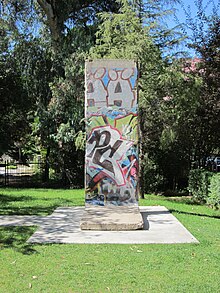| This article is an orphan, as no other articles link to it. Please introduce links to this page from related articles; try the Find link tool for suggestions. (October 2022) |
You can help expand this article with text translated from the corresponding article in Albanian. (May 2023) Click for important translation instructions.
|
| Postbllok Memorial | |
|---|---|
| Artist | Fatos Lubonja, Ardian Isufi |
| Year | 2013 (2013) |
| Location | Tirana, Albania |
| Coordinates | 41°19′15″N 19°49′12″E / 41.32095°N 19.82010°E / 41.32095; 19.82010 |



The Postbllok Memorial is a work of installation art by writer Fatos Lubonja and artist Ardian Isufi.
It is a memorial to the atrocities of the People's Socialist Republic of Albania and opened on March 26, 2013, on Dëshmorët e Kombit Boulevard in Tirana.
Location
The memorial is located near a statue of Ismail Qemali in the neighborhood where the nomenklatura built their dachas, and in fact is in what was once the garden of the dacha of Mehmet Shehu.
Description and symbolism
The Postbllok Memorial includes three pieces. One is a set of concrete girders taken from Spaç Prison, where Lubonja was imprisoned for a time. The girders are lined up in a row as they would have been in the halls of the Prison.
The second object is a bunker portion of the memorial, one of the main symbols of the dictatorship.
The third element is a piece of the Berlin Wall, meant to symbolize Albania's isolation, which was a gift from the state government of Berlin to the City of Tirana.
References
- ^ "U përurua dje memoriali me simbolet e diktaturës "Postbllok" konceptuar nga Ardian Isufi dhe Fatos Lubonja" [The "Postbllok" memorial with the symbols of the dictatorship conceived by Ardian Isufi and Fatos Lubonja was inaugurated yesterday]. Shqip (in Albanian). March 27, 2013. Retrieved 17 October 2020.
- "Galeri fotografike: Përurimi i memorialit për izolimin komunist "Post Blloku"" [Photo gallery: Inauguration of the memorial for communist isolation "Block Post"]. Embassy of Germany in Albania (in Albanian). Archived from the original on 6 October 2013.
- ^ "Tiranë, promovohet "Postbllok", vepra kundër sundimit totalitar" [Tirana, "Postblock" is promoted, the work against totalitarian rule]. Shqiptarja (in Albanian). March 26, 2013. Archived from the original on March 29, 2013. Retrieved 17 October 2020.
- ^ "Memoriali "Post- Bllok" nëpërmjet fotove!" [Memorial "Post-Blok" through photos!]. Panorama (in Albanian). March 26, 2013. Archived from the original on March 28, 2013. Retrieved 17 October 2020.